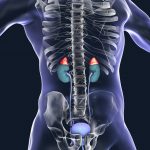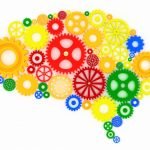Gary Weiner, ND, LAc
With a plethora of IBD cases in our clinic, we find effective treatment requires a strategic approach integrating conventional use of medications such as corticosteroids, anti-inflammatories, immunosuppressants, and biologic medications with the therapies that stimulate the vital force, treat assumed causes, and remove the obstacles preventing remission.Inflammatory bowel disease (IBD), comprised of ulcerative colitis (UC) and Crohn’s disease (CD), is one of the 5 most prevalent gastrointestinal diseases in the United States. It is without a medical cure, often requires a lifetime of care,1 and can be difficult to manage with either conventional or unconventional treatment.
The naturopathic physician’s contribution to an integrative paradigm can be visualized like a wheel or “tire,” with the center hub being a dietary strategy. The dietary strategy gets the wheel of treatment rolling. The spokes point to obstacles that need to be removed as the dietary strategy is implemented. Outside of the wheel are some guiding sign posts that reinforce a successful clinical journey through a waxing and waning disease with large bumps in the road. With each bump, the naturopathic physician keeps the patient moving forward lest he head for more aggressive interventions without good integrative care.
The Center of the Hub: Implementing the Dietary Strategy
A dietary strategy remains the center of treatment in our clinic. This is rarely as simple as cleaning up a “Standard American Diet” or as easy as eliminating food allergies and intolerances, attempting a “Paleolithic diet,” or using the “anti-inflammatory” diet with its grains, fiber and seeds that are abrasive to an acute gut. Instead, we often implement the Specific Carbohydrate Diet™ (SCD) as the principal dietary strategy. With full support (hours of counseling and weekly follow-up for the first 6-8 weeks), we frequently see satisfactory management of acute symptoms and mucosal healing over time. The diet was developed based on the principle that specifically-selected carbohydrates, requiring minimal digestive processes, are absorbed and leave virtually none to be used for furthering microbial growth in the intestine.2 The SCD has not been studied sufficiently for integration into conventional care; however, one case series from the University of Massachusetts shows clinical correlation with the positive outcomes3 observed in our clinic, where over 80% of the cases respond with improvement. Additionally, a 2013 retrospective study from the University of Washington and Seattle Children’s Hospital shows promising outcomes with SCD in pediatric CD patients, and invites further prospective studies to validate efficacy.4
We begin an introductory phase of the SCD, as outlined by Elaine Gottschall in Breaking the Vicious Cycle,2 and expand it over time, adding foods to develop a unique “safe list” for the patient that will support intestinal healing. This phase typically begins with little fiber, and choices such as broiled fish, dry cottage cheese, eggs, apple cider, gelatin, chicken soup and pureed carrots. Over time, and only with careful supervision, we add vegetables and fruits that are well-cooked and deseeded, while meats are simply prepared. With tolerance and emerging remission, we add greater variety, including more complex cooking styles, and raw fruits and vegetables. Legumes are withheld until later phases. Particular cultured dairy products are included; however, we complete ELISA food allergy and cytotoxic testing to modify the diet, eliminating foods for improved outcomes. There is reason to believe allergy and intolerance are factors in the IBD gut, though it has not been proven as a cause.5 We interpret tests as potentially useful information, noting no evidence in research to validate reliability.6,7
Studies conclude that diet is relevant to the manifestations of the IBD, perhaps related to etiology but rarely supporting any particular dietary treatment approach.8 A particular dietary etiopathogenesis has never been defined,9 although data suggests that short-chain carbohydrates (FODMAPS) appear to play a role in the induction of functional gut symptoms,10 and excess intake of refined carbohydrates, low intake of fruits and vegetables, and overconsumption of polyunsaturated and monounsaturated fatty acids, compared to omega-3 fatty acids in the diets of industrialized nations, appear to be associated with increased risk of the disease.11
In my experience, gastroenterologists and dieticians are unprepared to support patients through dietary trials necessary to contribute to healing this condition nutritionally. Correct counseling and support is painstaking and it may take months to see progress with the evolution of the “safe” list that will contribute to mucosal healing.
When our dietary strategy does not take us on a direct route to remission of IBD, that is, when the correct dietary strategy plateaus, we consider the obstacles that have to be removed, or at least addressed, in order to make progress.
Obstacle 1: Dysbiosis
It is widely agreed that the main cause of IBD is a disruption of the normal microbiota,12 which consists of at least 1000 species of bacteria. The delicate symbiotic relationship between microbiota and host appears lost in IBD. Suspected pathogens are many, including Mycobacterium avium subspecies paratuberculosis, Yersinia, Pseudomonas, Salmonella, Campylobacter jejuni, Clostridum difficile, Adenovirus, Mycoplasma, Ruminococus gnavus, Fusobacterium varium, Escherichia coli,13 fungal flora such as Candida spp, Penicillium spp, Saccharomyces spp,14 and other organisms. However, any specific patterns of disturbance elude firm conclusions. The lack of clarity in defining the best probiotic therapy is equally as inconclusive as defining a pathogen, although it seems clear that an increased propensity of obligatory aerobic bacteria is seen displacing the anaerobic species, with both bifidobacteria (in CD) and Lactobacilli (in UC) being deficient in the IBD microbiota.15 On the other hand, different types of disturbances in microbiota may be responsible for UC and CD, with absence of butyrate-producing species being deficient in UC.16 In our practice, butyrate enemas can be ameliorative in UC with some validating research showing efficacy.17 While patients often respond to simple introduction of antibiotic or probiotic agents, we find it rare to see clear remission with single-agent, antimicrobial or probiotic therapy. In fact, patients can be aggravated by these therapies.
The following are our guidelines for treating IBD:
- Have faith in a well-chosen dietary strategy such as the SCD and the “safe list” to address dysbiosis.
- Address suspected pathogenic organisms and dysbiotic overgrowth with additional therapies.
- Use laboratory testing, however imperfect, to gather information; send stool samples to at least 2 different labs with different methods of organism recovery, assess small intestinal bacterial overgrowth (SIBO) with breath testing, look “under the carpets” with antibody testing offered by various labs, and consider methods such as organic acid testing.
- Review medical records to determine organisms treated previously.
- Use accumulated data to treat, based on findings.
Assume dysbiosis in spite of the normal lab findings, and select strategies depending on circumstances, findings, strength of patient, and pattern of dysbiosis.
Select the most effective agents that will be tolerated, including pharmaceuticals, Chinese and western herbs, selective antimicrobial, antifungal, or symbiotic agents; given the sensitivity of these patients to many encapsulated supplements and some well-indicated decoctions at full strength, we find biotherapeutic drainage strategies employing diluted botanicals to be useful.
Implement probiotics and prebiotics strategically, often starting with single organisms like Lactobacillus acidophilus and Saccharomyces boulardii, and progress in complexity, watching responses. VSL #3 remains the most researched probiotic for IBD showing efficacy,18 and we have had a few cases where it has been extremely effective in stimulating remission; however, we usually avoid the B bifidus contained within it, due to more frequent aggravations.
Consider recent advances in fecal microbiota transplantation (FMT)19,20 and helminthic therapy,21 both showing considerable promise as a therapy to effectively restore gut ecology.
Obstacle 2: Immune Dysregulation
Dysbiosis is thought to trigger immune dysregulation with related microbial host-antigen reactivity.22 The obstacle of an upregulated immune system appears best removed through implementation of the dietary strategy, repairing gut permeability, addressing dysbiosis, assuring adequate nutritional support, and removing the other obstacles discussed herein. We consider adding specific agents to impact dysregulation, including guggulsterone, Boswellia, psyllium, bromelain, Curcuma longa (turmeric), Potentilla erecta (tormentil), Ulmus fulva (slippery elm), Glycyrrhiza glabra (licorice), butyrate, aloe vera, and others.23 Low-dose naltrexone (LDN) has been helpful in many of our cases for maintaining remission. Some limited studies validate its use.24
Obstacle 3: Intestinal Permeability
Increased intestinal permeability is present in a large number of IBD cases.25 Intestinal permeability is usually greater in CD than in UC.26 In our view, effective dietary and dysbiosis strategies can repair intestinal permeability; however, employing other supplemental support is helpful in removing this obstacle. We use probiotics, lactoferrin, glutamine, digestive enzymes, betaine hydrochloride (HCl), antioxidants, and hydrolyzed fish protein, among other agents. Performing a urinary lactulose/mannitol test at the beginning of a treatment will often (but not predictably) demonstrate permeability, and as cases resolve, the test will typically show improved or normal permeability.
Obstacle 4: Nutritional Insufficiencies
IBD patients are at risk for nutrient deficiencies as a consequence of long-term gut inflammation and decreased oral intake, and malnutrition is a significant risk, especially in CD.27 In our clinic, we see frequent nutritional deficiencies in CD, while UC appears more stable, except during flares. We screen specifically for vitamin B12 (using the methylmalonic acid test), vitamin D, folic acid (especially if patients are on methotrexate), iron (usually low with chronic GI bleeding), zinc, selenium, and all essential and non-essential amino acids. As many IBD patients cannot tolerate oral iron, we consider IM or IV injections, or compounded transdermal iron as ferric ammonium chloride when iron deficiency anemia is present. Studies have concluded that correcting nutritional deficiencies in IBD patients through enteral and parenteral nutrition can induce remissions.28 Given absorption problems and gross micronutrient deficiencies and insufficiencies, we start most IBD patients on IV drips for 4-6 weeks, to provide baseline micronutrients in an environment of intestinal distress as we implement a dietary strategy and attempt to stimulate remission.
Obstacle 5: Suboptimal Digestion
We pay attention to the entire GI tract, which means addressing possible functional hypochlorhydria, pancreatic insufficiency (PI), bile acid insufficiency, and also bile acid malabsorption, which is a common feature of CD.29 PI is often associated with IBD with frequent bowel movements. There is little data to support HCL supplementation in IBD; however, we have seen profound improvement using this and even have one case where HCL supplementation has been responsible for sustained symptom remission. It is helpful to use laboratory testing to assess functional digestion and absorption problems, and then treat accordingly with tolerated agents and strategies.
Obstacle 6: Stressors and Psycho-Emotional Issues
Stress appears to be a trigger and perhaps an antecedent of IBD, though data on interventions are poorly documented.30 The possible mechanisms by which stress could be translated into IBD symptoms include changes in motor, sensory and secretory gastrointestinal function, increased intestinal permeability, and changes in the immune system.31 Likewise, the relationships between the hypothalamic-pituitary-adrenal (HPA) axis activity, hypocorticism, and glucocorticoid receptor dysfunction have been tied to inflammatory and autoimmune diseases.32 Depression and anxiety are prevalent in patients with IBD and may influence disease expression.31 One study showed that a significant number of IBD patients felt that antidepressant treatment positively influenced their IBD.33
In our clinic we integrate classical acupuncture, homeopathy, counseling, and neural therapy, either through treatment in the clinic, or referral. If anxiety and depression are present, remedies (natural or pharmacologic) must be incorporated into the plan. We teach mindfulness-based stress reduction (MBSR) in our clinic in 8-week cycles, as outlined by Jon Kabat-Zinn.34 MBSR has been shown in several studies to impact inflammation in a variety of health conditions,35,36 and has been shown in one study to decrease C-reactive protein (CRP).37 Psycho-emotional imbalance and stress must be addressed in treatment for successful outcomes.
Obstacle 7: Adrenal Hypofunction
One obstacle in managing some IBD cases is functional adrenocortical insufficiency, as described at length in the text, The Safe Uses of Cortisol, by Jeffries.38 It is surprising how little data exists on this phenomenon despite widespread agreement that the HPA axis is relevant to the mechanism of IBD.39 We screen IBD patients to find significant numbers with low salivary cortisols, 24-hour urinary cortisols, and, in some cases, morning serum cortisols. When adrenal salivary testing reveals a low cortisol concentration, low DHEA-S, and low 17-OH-progesterone, we maintain a high confidence level that low-dose hydrocortisone may contribute to symptomatic, if not endoscopic, remission. One fatigue study published in The Lancet indicated that low-dose hydrocortisone (10 mg or less) is not suppressive of adrenal function.40 Some cases respond well to dessicated adrenal extract and various adrenal supplements, but we have had more success with low-dose hydrocortisone, given according to bioidentical hormone replacement principles, than any other oral therapy.
Obstacle 8: Constitutional Imbalance
We do not have data supporting treatment of the “constitutions” of our patients, and this is the least evidence-based area in naturopathic medicine. When we refer to treatment of the “constitution,” we are referring to a dominant pattern of symptoms that lead us to prescriptions of homeopathic remedies, Chinese medicine treatments, and other interventions that we have learned about and frequently implement with success. We find it important to examine constitutional imbalances and address them as they present themselves, whether employing the simillimum using classical prescribing, or treating the indicated miasm or “reactional mode” using polypharmacy techniques. In our clinic, most patients receive acupuncture once a Chinese differential diagnosis has been established. A significant number of our IBD patients are intolerant of Chinese herbal formulas, except when they are well along the path to remission.
Manage the Acute Competently
Before going for the “root” of the condition, it is necessary to get acute symptoms under control. A shopping bag of hard-to-digest supplements will rarely do the job, so we rely on acupuncture, a well-chosen homeopathic remedy, the introductory phase of SCD, and, when necessary, oral corticosteroids to “manage” acute symptoms. Of course, there are other methods to consider, such as an “elemental diet,”41 which has shown to be as effective as corticosteroids. We advise new doctors to refer for management of a flare if they are not confident and to request that the patient return when the flare is under control, and we recommend learning steroid protocols “cold,” to hold in reserve for when needed. We often compound a “friendlier” version of prednisone without binders and excipients through compounding pharmacies. We find that if we mismanage acute treatment, we may lose an IBD patient and miss the chance to work on the root of the condition.
Provide Necessary Support
IBD patients typically arrive in our clinic after exhausting other avenues of care. They often present, expressing confusion about the choices they face, experiencing a conflict of paradigms, ie, between conventional treatments offering less-than-promising results and with dangerous side effects, and alternative and complementary care that is driven by a different set of principles and using treatments that appear to lack “proven results.” Patients may have been discouraged by medical professionals to engage in naturopathic therapies, or been told that “diet doesn’t matter.” What we ask of the patient – ie, to embrace a new paradigm—is immense. And when patients are flaring, they do not have a lot of energy to invest in their wellness and embrace complicated treatment. In our clinic, we compensate for this with a staff member, an occupational therapist who specializes in helping IBD patients to implement the necessary lifestyle changes to assure a successful treatment plan. We have set up systems, personnel, and a reimbursement strategy to provide programmatic assistance to help patients get well. The waxing and waning of IBD requires frequent follow-up, careful monitoring, and availability to address flares.
Monitor Responses Carefully
As physicians, we believe it is important to share the concerns of gastroenterologists, not only to monitor signs and symptoms, but to assure mucosal healing and prevention of colorectal cancer, which occurs in a significant number of IBD patients.42 Regular surveillance appears necessary,43 with colonoscopy considered the gold standard for diagnosing early dysplastic alterations. It is also important to use biomarkers to assess clinical progress.44 Fecal biomarkers such as calprotectin and lactoferrin, as well as serological markers such as ESR and CRP, are valuable to gather at baseline and to monitor over time as a dietary strategy is implemented and obstacles to remission are removed.45,46 These markers are invaluable in helping to assess degrees of mucosal healing prior to further endoscopy, although mucosal healing has been defined as “complete absence of all inflammatory and ulcerative lesions in all segments of gut” at endoscopy.47
Integrate, Don’t Separate
IBD is one of those conditions where the troubling symptoms, profound discomfort of our patients, and the serious health risks of disease progression test our philosophical resolve. We employ sound naturopathic measures, and yet sometimes we cannot get the symptoms under control and stimulate mucosal healing. This is no time for philosophical grandstanding about what is natural; we need to be integrative and remember that we are physicians “specializing” in natural therapeutics but trained (and in many locales, licensed) to use pharmacologic agents appropriately. This is a disease in which management requires integration of our naturopathic skills with some of the modalities of our allopathic brothers and sisters.
IBD is where the rubber meets the road. The contact point of the tire (our medicine) with the road (the patient’s experience of the disease) should yield positive results. However, when we do not see adequate progress, the symptomatic and pathological pushback is so great that there had better be tread on those naturopathic tires.
The needed tread is integration, not separation. As we proceed with our pursuit of the condition’s root, we apply multiple therapies, observe the outcomes, adjust therapies as we go, and maintain awareness of our patient’s responses. We assume the responsibility to manage the case, or work with gastroenterologists or other providers to add medications when the condition flares, or remove medications when we begin to see signs that the vis medicatrix naturae will take the patient, as it often does, to the promised land.
 Gary Weiner, ND, LAc practices at Pearl Natural Health in Portland, Oregon, where he has developed an alternative and complementary care program for inflammatory bowel disease. He graduated from NCNM in 1997 and completed a 1-year residency in family medicine. He has served as adjunct faculty and clinical supervisor at NCNM, and is on the medical advisory board of the Northwest Crohn’s and Colitis Foundation of America. He was recently invited and presented continuing education in complementary care for IBD to 50+ gastroenterologists at the 2013 meeting of the Oregon Gut Club, accredited by Providence Portland Medical Center. Dr Weiner lives with his wife and daughter.
Gary Weiner, ND, LAc practices at Pearl Natural Health in Portland, Oregon, where he has developed an alternative and complementary care program for inflammatory bowel disease. He graduated from NCNM in 1997 and completed a 1-year residency in family medicine. He has served as adjunct faculty and clinical supervisor at NCNM, and is on the medical advisory board of the Northwest Crohn’s and Colitis Foundation of America. He was recently invited and presented continuing education in complementary care for IBD to 50+ gastroenterologists at the 2013 meeting of the Oregon Gut Club, accredited by Providence Portland Medical Center. Dr Weiner lives with his wife and daughter.
References
Centers for Disease Control and Prevention. Inflammatory Bowel Disease (IBD). CDC Web site. http://www.cdc.gov/ibd/. Accessed October 12, 2013.
Gottschall E. Breaking The Vicious Cycle: Intestinal Health Through Diet. Baltimore, Ontario, Canada: Kirkton Press; 2007.
Olendzki BC, Persuitte G, Silverstein T, et al. Pilot Testing a Novel Treatment for Inflammatory Bowel Disease. Clinical and Translational Science Research Retreat, May, 2011. http://works.bepress.com/barbara_olendzki/46. Accessed: October 12, 2013.
Suskind DL, Wahbeh, G, Gregory, N, et al. Nutritional Therapy in Pediatric Crohn’s Disease: The Specific Diet. J Pediatr Gastroenterol Nutr. 2013 Sept 16. [Epub ahead of print]
Mishkin S. Dairy sensitivity, lactose malabsorption, and elimination diets in inflammatory bowel disease. Am J Clin Nutr. 1997;65(2):564-567.
Wüthrich B. Unproven techniques in allergy diagnosis. J Investig Clin Immunol. 2005;15(2):86-90.
Gerez IF, Shek LP, Chng HH, Lee BW. Diagnostic tests for food allergy. Singapore Medical J. 2010;51(1):4-9.
Hou JK, Lee D, Lewis J. Diet and Inflammatory Bowel Disease: Review of Patient-Targeted Recommendations. Clin Gastroenterol Hepatol. 2013 Oct 6. pii: S1542-3565(13)01512-7.
Weinand I, Jordan A, Caspary WF, Stein J. Nutrition in the etiopathogenesis of chronic inflammatory bowel diseases. Z Gastroenterol. 1997;35(8):637-649.
Gearry RB, Irving PM, Barrett JS, et al. Reduction of dietary poorly absorbed short-chain carbohydrates (FODMAPs) improves abdominal symptoms in patients with inflammatory bowel disease-a pilot study. J Crohns Colitis. 2009;3(1):8-14.
Spooren CE, Pierik MJ, Zeegers MP, et al. Review article: the association of diet with onset and relapse in patients with inflammatory bowel disease. Aliment Pharmacol Ther. 2013;38(10):1172-1187.
Kleessen B, Kroesen AJ, Buhr HJ, Blaut M. Mucosal and invading bacteria in patients with inflammatory bowel disease compared with controls. Scand J Gastroenterol. 2002;37(9):1034-1041.
Elliott TR, Hudspith BN, Wu G et al. Quantification and Characterization of Mucosa-Associated and Intracellular Escherichia coli in Inflammatory Bowel Disease. Inflamm Bowel Dis. 2013;19(11):2326-2338.
Scaldaferri F, Gerardi V, Lopetuso LR, et al. Gut microbial flora, prebiotics and probiotics in IBD: their current usage and utility. BioMed Res Int. 2013;2013:435268.
Fung QM, Szilagyi A. Carbohydrate Elimination or Adaptation Diet for Symptoms of Intestinal Discomfort in IBD: Rationales for “Gibsons’ Conundrum.” Int J Inflamm. 2012;2012:493717.
Machiels K, Joossens M, Sabino J, et al. A decrease of the butyrate-producing species Roseburia hominis and Faecalibacterium prausnitzii defines dysbiosis in patients with ulcerative colitis. Gut. 2013 Sep 10. doi: 10.1136/gutjnl-2013-304833.
Pacheco RG, Esposito CC, Müller LC, et al. Use of butyrate or glutamine in enema solution reduces inflammation and fibrosis in experimental diversion colitis. World JGastroenterol. 2012;18(32):4278-4287.
Uronis JM, Arthur JC, Keku T, et al. Gut microbial diversity is reduced by the probiotic VSL#3 and correlates with decreased TNBS-induced colitis. Inflamm Bowel Dis. 2011;17(1):289–297.
Damman CJ, Miller SI, Surawicz CM, Zisman TL. The microbiome and inflammatory bowel disease: is there a therapeutic role for fecal microbiota transplantation? Am J Gastroenterol. 2012;107(10):1452-1459.
Smits LP, Bouter KE, de Vos WM, et al. Therapeutic potential of fecal microbiota transplantation. Gastroenterology. 2013;145(5):946-953.
Elliott DE, Weinstock JV. Helminth–host immunological interactions: prevention and control of immune-mediated diseases. Ann N Y Acad Sci. 2012;1247:83–96.
Shih DQ, Targan SR. Insights into IBD Pathogenesis. Curr Gastroenterol Rep. 2009;11(6):473–480.
Ke F, Yadav PK, Ju LZ. Herbal medicine in the treatment of ulcerative colitis. Saudi J Gastroenterol. 2012;18(1):3–10.
Smith JP, Bingaman SI, Ruggiero F, et al. Therapy with the opioid antagonist naltrexone promotes mucosal healing in active Crohn’s disease: a randomized placebo-controlled trial. Dig Dis Sci. 2011;56(7):2088–2097.
Fries W, Belvedere A, Vetrano S. Sealing The Broken Barrier in IBD: Intestinal Permeability, Epithelial Cells and Junctions. Curr Drug Targets. 2013 Sep 23. [Epub ahead of print]
Oriishi T, Sata M, Toyonaga A, et al. Evaluation of intestinal permeability in patients with inflammatory bowel disease using lactulose and measuring antibodies to lipid A. Gut. 1995;36(6):891–896.
Alkhouri RH, Hashmi H, Baker RD, et al. Vitamin and mineral status in patients with inflammatory bowel disease. J Pediatr Gastroenterol Nutr. 2013;56(1):89-92.
Nirooshun Rajendran and Devinder Kumar. Role of diet in the management of inflammatory bowel disease. World J Gastroenterol. 2010;16(12):1442–1448.
Lenicek M, Duricova D, Komarek V, et al. Bile acid malabsorption in inflammatory bowel disease: assessment by serum markers. Inflamm Bowel Dis. 2011;17(6):1322-1327.
Konturek PC, Brzozowski T, Konturek SJ. Stress and the gut: pathophysiology, clinical consequences, diagnostic approach and treatment options. J Physiol Pharmacol. 2011;62(6):591-599.
Mikocka-Walus AA, Turnbull DA, Moulding NT, et al. Controversies surrounding the comorbidity of depression and anxiety in inflammatory bowel disease patients: a literature review. Inflamm Bowel Dis. 2007;13(2):225-234..
Silverman MN, Sternberg EM. Glucocorticoid regulation of inflammation and its behavioral and metabolic correlates: from HPA axis to glucocorticoid receptor dysfunction. Ann N Y Acad Sci. 2012;1261:55–63.
Mikocka-Walus AA, Gordon AL, Stewart BJ, Andrews JM. A Magic pill? A qualitative analysis of patients’ views on the role of antidepressant therapy in inflammatory bowel disease (IBD.) BMC Gastroenterol. 2012;12:93.
Kabat-Zinn J, Santorelli SF. Mindfulness-Based Stress Reduction (MBSR) Professional Education and Training Course Notes. [MBSR Curriculum and Supporting Materials] University of Massachussetts Medical School. Amherst, MA; 2009.
Rosenkranz MA, Davidson RJ, Maccoon DG, et al. A comparison of mindfulness-based stress reduction and an active control in modulation of neurogenic inflammation. Brain Behav Immun. 2013;27(1):174-184.
Creswell JD, Irwin MR, Burklund LJ, et al. Mindfulness-Based Stress Reduction training reduces loneliness and pro-inflammatory gene expression in older adults: a small randomized controlled trial. Brain Behav Immun. 2012;26(7):1095-1101.
Fang CY, Reibel DK, Longacre ML,et al. Enhanced psychosocial well-being following participation in a mindfulness-based stress reduction program is associated with increased natural killer cell activity. J Altern Complement Med. 2010;16(5):531–538.
Jeffries WM. The Safe Uses of Cortisol. Springfield, IL: Charles C Thomas Pub Ltd; 1996.
Bonaz B. Inflammatory bowel diseases: a dysfunction of brain-gut interactions? Minerva Gastroenterol Dietol. 2013;59(3):241-259.
Cleare AJ, Heap E, Malhi GS, et al. Low-dose hydrocortisone in chronic fatigue syndrome: a randomised crossover trial. Lancet. 1999;353(9151):455-458.
Gorard DA, Hunt JB, Payne-James JJ, et al. Initial response and subsequent course of Crohn’s disease treated with elemental diet or prednisolone. Gut. 1993;34(9):1198-1202.
Dyson JK, Rutter MD. Colorectal cancer in inflammatory bowel disease: What is the real magnitude of the risk? World J Gastroenterol. 2012;18(29):3839–3848.
Connelly TM, Koltun WA. The Cancer “Fear” in IBD Patients: Is it still REAL? J Gastrointest Surg. 2013 Sep 4. [Epub ahead of print]
Basso D, Zambon CF, Plebani M. Inflammatory bowel diseases: from pathogenesis to laboratory testing. Clin Chem Lab Med. 2013 Oct 9:1-11. [Epub ahead of print]
Caccaro R, D’Incà R, Pathak S, Sturniolo GC. Clinical utility of calprotectin and lactoferrin in patients with inflammatory bowel disease: is there something new from the literature? Expert Rev Clin Immunol. 2012;8(6):579-585.
Lewis JD. The utility of biomarkers in the diagnosis and therapy of inflammatory bowel disease. Gastroenterology. 2011;140(6):1817–1826.
Mazzuoli S, Guglielmi FW, Antonelli E, et al. Definition and evaluation of mucosal healing in clinical practice. Dig Liver Dis. 2013 Aug 6. pii: S1590-8658(13)00224-7.





